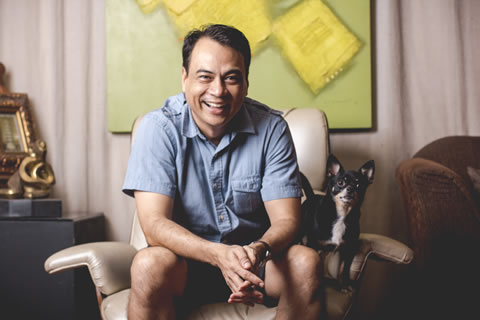The super groovy, multi-talented author talks with us about writing in different mediums, 70s pop-culture references, and disco love stories before the 20th Anniversary Re-release of his seminal novel, Rolling the R’s!
Rolling the R’s is a coming-of-age story primarily about young people. Who were you reading when you were a young person?
Judy Blume was one of the first YA and American writers I read when I moved to Hawaii. I also loved Paul Zindel’s “The Pigman” and Scott O’Dell’s “Island of the Blue Dolphins,” as well as the Ralph and Ramona series by Beverly Cleary. In high school (mid-80s), which is when I started to fall in love with reading books outside of school work and toying with the idea of writing stories and poems, it was Charles Bukowski and Raymond Carver, particularly his dramatic poem in the voice of Charles Bukowski that sped me towards the creative writing direction.
You’ve lived in Manila, London, Madrid, San Francisco, and Honolulu. How has living in different locations influenced your writing?
I consider place as a very important tool in my writing. It is more than just setting, props that have to take a backseat to other elements of fiction, namely character and plot. In fact, I treat setting as one of my main characters, if not part of the story. There would be no story—or soul to the story and characters—if I did not give place the same priority, in the same manner that Faulkner’s and Garcia Marquez’s famous novels would collapse if they did not give equal dedication. Reduce Yoknapathawpa and Macondo to settings and you’re basically excising the core of As I Lay Dying and One Hundred Years of Solitude. Because I place so much emphasis on setting in my writings, it often means really knowing the place well enough to write about it with confidence. It means knowing the locals, their culture and history. Researching about the place, for me, is not enough. I have to go and live there. Other writers can write about a place they’ve only visited for a week. Some have done it without setting a foot there. I’m not one of those writers. This is one of the reasons why it took me twelve years to write my second novel Leche. I not only had to re-educate myself about Manila, the colonial history of the Philippines in the past one hundred years in relation to the landmark of the city, but I also had to navigate in and out of the labyrinth that characterizes Manila. The same with Rolling the R’s. Remove Kalihi and the novel loses its color. It is Kalihi—and the Pidgin English dialect—that makes the novel unique.
Kaya Press will soon publish the 20th anniversary reprint of Rolling the R’s. Reflecting on the 20 years that have passed since you wrote this book, how might you write Rolling the R’s differently now?
I won’t dare touch it. Rewriting should only happen during the editing process, not post-publication. I’ll leave that to writers like Joyce Carol Oates who rewrote her first novel. I am, thank god, not the same writer that wrote Rolling. I was in a different intellectual, creative, and personal space. We’re talking a twenty-year gap. Lots of things have happened to me. I’ve experienced loads of failures and frustrations, but enough prayers answered to keep me going. I can’t even go back and reclaim the energy, the verve, the exhilaration that accompanied the creation of those vignettes. I can only remember it being similar to someone walking through a dream, or grief. What Rolling gave me was lessons in writing, pre and post. I don’t see it as my baby at all. More like a teacher.
The use of pidgin and dialect must have been a risky move, especially at the time of writing Rolling the R’s. What made you feel that pidgin was necessary to the book?
Like Kalihi, Pidgin is another major character in the novel. Remove it and there would be no Edgar, no Katrina, no tension between them and their teacher. There would be no local culture. No pride in them being local. It definitely was a risky move, but only risky if I were thinking of my audience. I had none. I was more interested in writing the stories, in finding out what happened next to the characters, and the world of Kalihi that was unfolding at a fast pace.
Rolling the R’s includes song lyrics, poems, nonlinear narratives, report cards, and dialect. What made you feel like all these different media forms could be used together to form a narrative?
These media forms I had no say in. The prose came out in these forms because I did not dictate a dominant one when I was writing Rolling. If the story was best told in the form of a poem, then poetry it was. If it were straight out dialogue, then it took the form of a one-act play. These forms, which I now see as tools, were popular forms I remember growing up with—chain letters, report cards, writing lyrics to our favorite songs and inserting them through the makeshift pockets of our colored plastic-covered portfolios, along with photographs and stickers.
There are a lot of 70’s and 80’s pop culture references made in the book, including a lot of songs that people might remember. Clearly, music is an important part of the lives of the main characters; does music play an equally important part in your life? What’s your favorite song mentioned in the book, and why?
Most of the pop culture references are in the late 70s, with the exception of the movie Making Love, which came out in the early 80s. I really tried to stick to the 70s in Rolling. But I bent the rules with Making Love. Now, about the songs. You’re right, it’s definitely one of the driving forces of this pop culture-crazed novel. The characters use the songs—movies, disco dancing—for different purposes. For the Filipino locals Edgar and Trina, they use disco songs and other American popular culture staples to express themselves, their desires, their dreams. For the immigrants Florante and Vicente, these songs become anthems to the new world they’re struggling to understand and be part of.
In honor of the upcoming USC Visions and Voices event, could you talk about the seminal Dogeaters by Jessica Hagedorn and Blu’s Hanging by Lois-Ann Yamanaka, and how they’ve influenced you and your writing?
I’m not sure if “influence” is the right word because I was already writing non-linear, collage-like stories prior to Dogeaters, and Blu’s Hanging was published two years after Rolling. If anything, I was definitely inspired to keep writing because of these two writers.
What Dogeaters showed me was the limitless possibilities of what a novel can do. It was mind-blowing. And I owe this experience to my classmates, Justin Chin and Lois-Ann Yamanaka, who introduced me to the works of Jessica Hagedorn. First with Dangerous Music and Pet Food & Other Tropical Apparitions. Dogeaters also intensified my desire to return to my birthplace, a feeling that was ignited a year before, when I was living in Madrid. I did not feel such longing for the motherland when I was living in Hawaii, probably because there were pockets of little Philippines throughout the islands. It wasn’t until I left Hawaii to go and study abroad in London (which I ended up dropping out of, in exchange for Madrid) that this longing to return home became a preoccupation.
Lois-Ann was in my writing group, along with Justin, Lisa Asagi, and Lori Takayesu. We inspired and encouraged each other to write and take the risks. Along with our teacher Faye Kicknosway, I credit them for helping me become the writer that I am today. We were all different. We came from different places and class backgrounds. Justin came from Malaysia, I was from the Philippines, Lois-Ann was from Hilo, Lisa grew up in Kalihi, and Lori was from Hawaii Kai. But we all shared the same hunger to write. We met once a week, were each other’s first editors. We workshopped Lois Ann’s poems that would comprise the collection, the ground-breaking, Saturday Night at the Pahala Theater. We also workshopped the vignettes that became part of Rolling The R’s.
What is your favorite place to write?
Anywhere, so long as the place inspires me. I would hate to be stuck in a place where my imagination goes on a sabbatical, or worse, attempts suicide. I’ve been there. It’s not a productive state for a writer to be in.
You’ve written novels, poems, and plays. Do you have a favorite genre?
None. I see them as inter-related, symbiotic. They feed off each other, the novel and, sometimes, poetry, being the two genres that are able to make room for such mixing.
We are asking all of our authors this questions so we can use it in our newsletter and website; In the spirit of aloha, can you write a one-sentence, Asian diasporic disco love story for us?
Halfway through “You and I” by Eddie Rabbit and Crystal Gayle, he locked me in an embrace and told me, with his hard-beating heart, what I had been fearing and dreaming of all these months: we were going to be each other’s beginnings.


Leave a Comment
We'd love to know what you think.